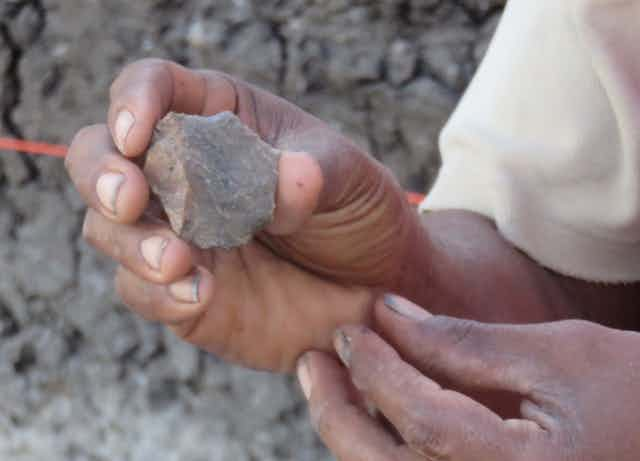The scientific debate continues over the bones of the mysterious human-like creature Homo floresiensis – nicknamed “Hobbits” – with the discovery of new fossils in the So'a Basin on the island of Flores, Indonesia, dating to 700,000 years ago.
But one often-overlooked aspect is that Homo floresiensis used technology —- in this case stone toolkits —- to adapt to the exotic Flores environment.

Island life
Homo floresiensis and its ancestors lived on Flores from about 1 million to 50,000 years ago, camping in limestone caves and on the banks of streams and lakes amid active volcanoes. It was a tropical landscape populated by miniature elephants, giant rats and Komodo dragons.
Analysis of these new fossils supports the hypothesis that Homo floresiensis evolved from a population of large-bodied Homo erectus that were stranded on the island and subjected to the “island rule”. This is where selective pressures unique to islands cause large-bodied animal species to become smaller over time.
Surprisingly, we now have evidence that the founding population of Homo erectus shrunk to Hobbit size and evolved into the new species, Homo floresiensis, within 300,000 years of arriving there.
This is a dramatically short period in evolutionary terms. Yet this hominin used tools they made to adapt to the Flores environment, which in turn raises interesting questions about the technological niche characteristic of the genus Homo.

The stone tools
Making stone tools might seem like a simple process. After all, how hard can it be to bash rocks together?
But, despite what you might assume, controlling the process is not easy. It requires complex mental evaluations of geometrical configurations on the stone, and blows that are simultaneously controlled and forceful
I taught myself ancient stoneworking to better understand these tools. As such, I have found that the coarse-grained volcanic river cobbles used by the So'a Basin hominins are very resistant to stone-flaking techniques.
You have to hit a volcanic rock exceptionally hard to initiate a fracture.
Even though Homo floresiensis adults were the size of a modern human five-year-old, they were capable of removing volcanic flakes up to 12cm long.
These hominins were small but powerful. They nevertheless had an eye for easier material, and frequently collected small, high-quality flint-like pebbles during their stone forays.
The toolkits themselves were simple, comprising knife-like flakes for various cutting tasks, and the stout-edged cobble cores they were struck from which were suitable as heavy chopping tools. The edges of the flakes were sometimes trimmed, perhaps to resharpen them or modify their shape.
You can see it here in three dimensions, thanks to Michael Curry from Sketchfab.
Stone tool sites
Although hominin skeletal remains have only been found at two Flores sites – Mata Menge and Liang Bua – this simple stone toolkit has been found at multiple sites in the So'a Basin dating up to 1 million years ago
The genesis of the hominin tool-making tradition is in Africa, with stone-flaking origins some 3.3 million years ago.
Stone toolkits allowed our ancestors to hack meat from tough animal carcasses and cut it into small pieces that were more easily chewed and digested Greater access to meat was a key factor in the evolution of a bigger body size and, crucially, a larger brain.
Equipped with toolkits similar to those on Flores, populations of Homo erectus left Africa by 1.8 million years ago and quickly fanned out across Asia. They arrived in Indonesia by 1.5 million years ago
Stranded
The Homo floresiensis story began when one population of Homo erectus became stranded on Flores about 1 million years ago. There are two reasons why this was among the most significant challenges ever faced by a Homo erectus population.
First, landing on Flores from a jumping-off point on Java or Sulawesi meant that Homo erectus was leaving behind familiar mainland Asian plants and animals to confront on Flores an exotic and unfamiliar mix of Australian and Asian species.
And second, unlike Homo erectus elsewhere in Asia, the Flores colonisers were tightly constrained by the boundaries of this small (13,500 sq km) island. The environmental resources available to them were strictly limited, and moving elsewhere during times of stress was not an option.
You might think that that their stone technology was an “ace in the hole” in confronting these challenges. After all, the global history of Homo sapiens shows that technology is a fabulous means for squeezing the maximum amount of energy possible from the environment.
But our analyses to date show that the Flores hominins continued making simple stone tools in much the same way over their entire million-year long occupation of the island.
Shrinking
While this was sufficient for the population’s survival, it was not sufficient to buffer it from the extremes of the selective pressures encountered on Flores.
Hence their skeletal anatomy and body shapes morphed and their cranial capacity dramatically decreased
Yet, paradoxically, Homo floresiensis didn’t lose the capability to make stone tools. Their brains reorganised to retain the complex cognitive abilities necessary to make and use their toolkit, and the dramatic changes in body shape must have accommodated the physical requirements of forceful stone-flaking.
The hominin’s technological abilities had entered an evolutionary cul-de-sac: crucial to the survival of these enigmatic creatures, yet unable to be enhanced to break free from the island rule.
The Homo floresiensis _story may be a lesson for all of us. There was nothing inevitable about the genus _Homo using technology to conquer the planet, and technology may not always serve as a firewall between us and the powerful forces of natural selection.

